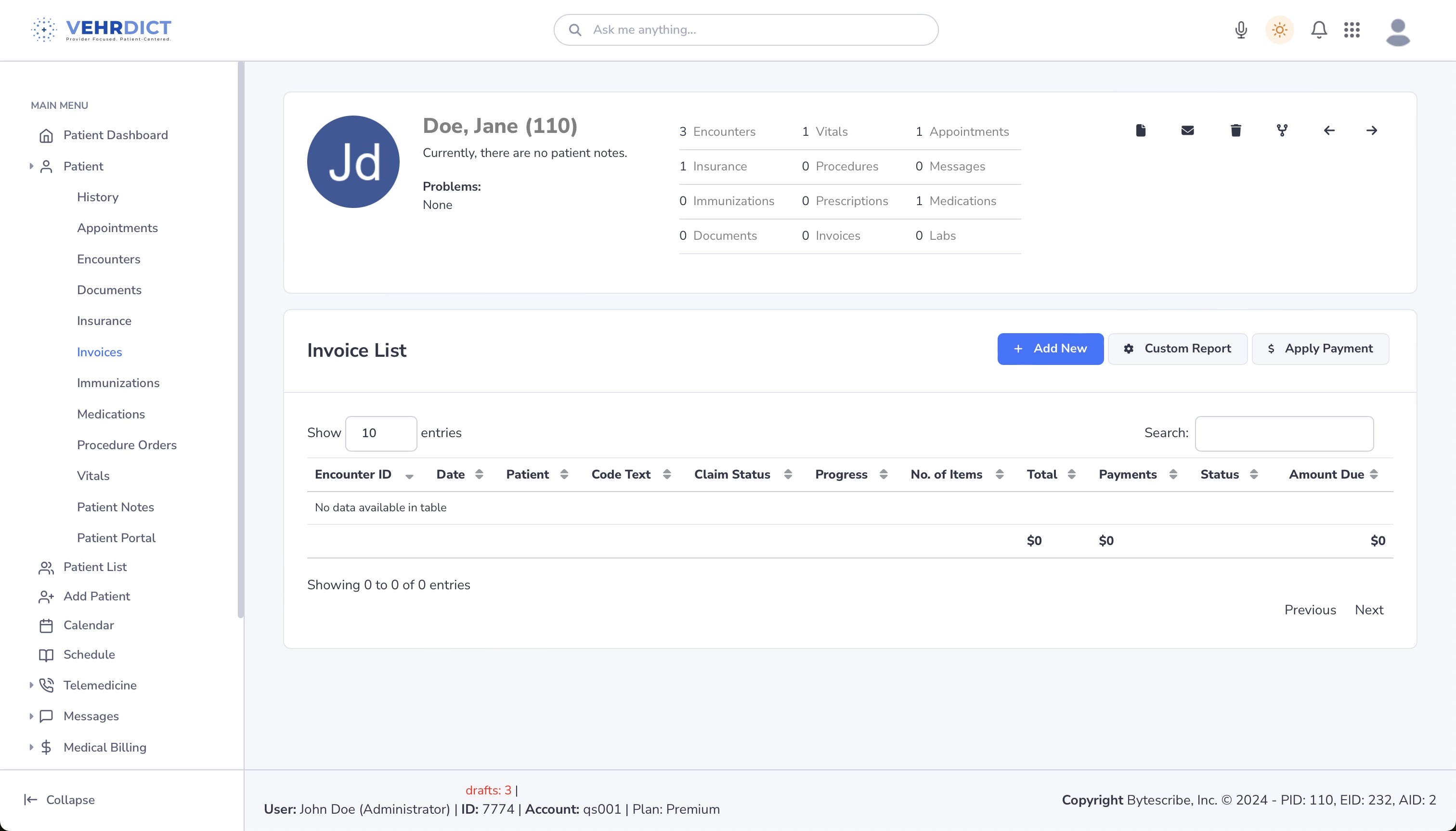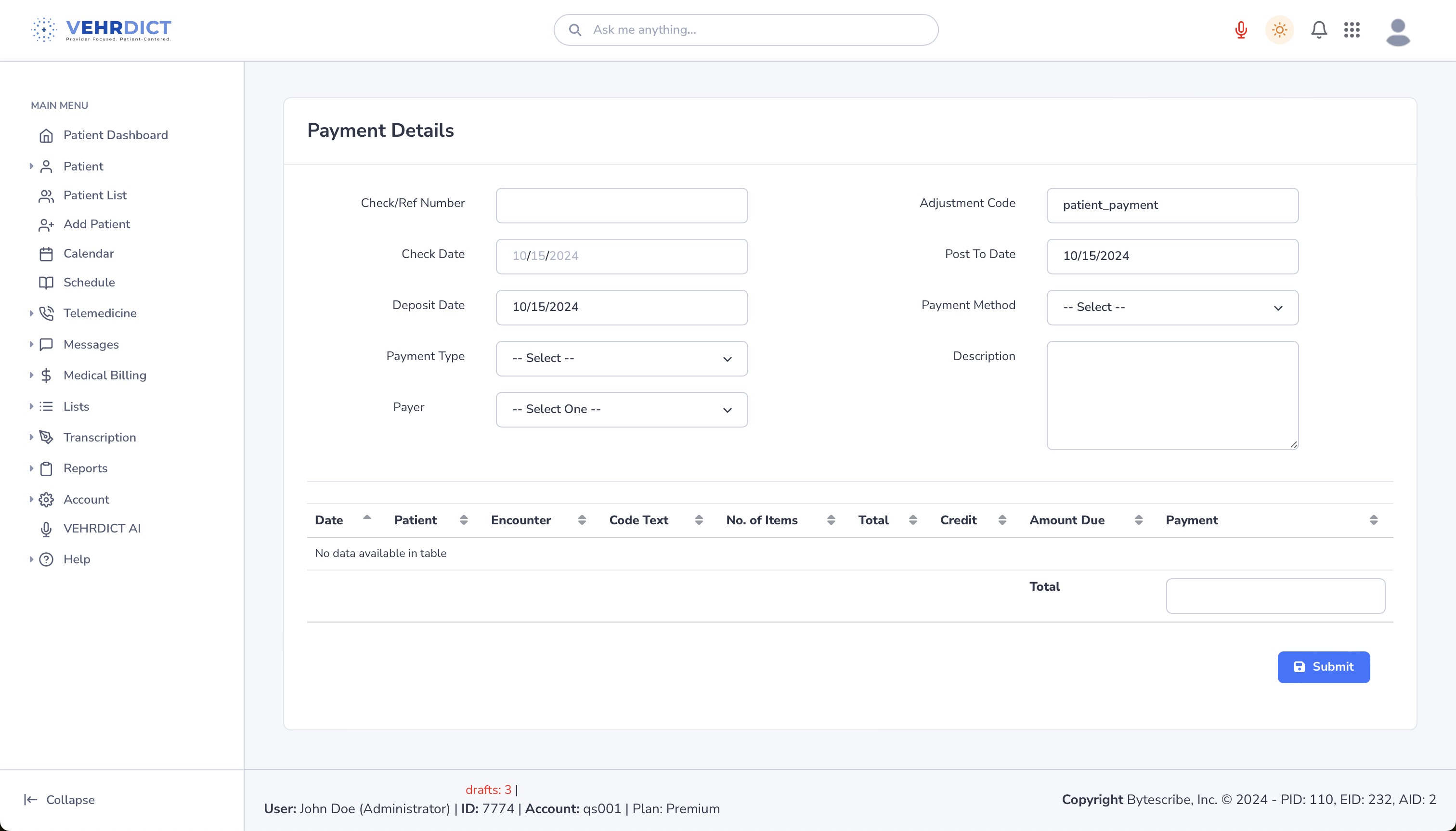Medical Billing: Difference between revisions
No edit summary |
No edit summary |
||
| Line 1: | Line 1: | ||
Medical billing in VEHRDICT is designed to be fast, intelligent, and highly accurate, thanks to its AI-driven automation. As clinical documentation is completed, VEHRDICT’s AI scans the notes and extracts relevant CPT, HCPCS, and ICD-10 codes, reducing the need for manual coding. This significantly speeds up the creation of invoices and insurance claims while minimizing errors. Providers also have access to a customizable list of favorite billing codes, making it easy to quickly select frequently used procedures and diagnoses for recurring visits or specialties. | |||
To further reduce administrative workload, VEHRDICT can automatically extract insurance information from scanned documents and PDFs using OCR (Optical Character Recognition) technology. This eliminates the need to retype policy details, ensuring more accurate and consistent insurance data entry. Additionally, VEHRDICT includes built-in insurance eligibility verification, allowing staff to confirm coverage in real time. Before submission, the system checks for completeness and compliance, helping identify any missing information that might lead to claim rejections. | |||
Once a claim is ready, VEHRDICT automatically submits it to a designated clearinghouse for processing. The entire lifecycle of each claim—including submission, acceptance, rejections, and payments—is tracked and updated within VEHRDICT. This allows billing staff and providers to easily monitor the status of every claim, quickly identify issues, and take corrective action when needed. The result is a more streamlined billing workflow, reduced claim denials, and faster reimbursement cycles. | |||
Medical billing is a critical part of the healthcare workflow, ensuring providers receive accurate and timely payments for services rendered. '''VEHRDICT''' offers an integrated billing workflow that begins at the point of patient care and ends with payment posting. From insurance verification to charge transmission and denial management, this guide outlines the full medical billing lifecycle. | Medical billing is a critical part of the healthcare workflow, ensuring providers receive accurate and timely payments for services rendered. '''VEHRDICT''' offers an integrated billing workflow that begins at the point of patient care and ends with payment posting. From insurance verification to charge transmission and denial management, this guide outlines the full medical billing lifecycle. | ||
Revision as of 18:08, 15 July 2025
Medical billing in VEHRDICT is designed to be fast, intelligent, and highly accurate, thanks to its AI-driven automation. As clinical documentation is completed, VEHRDICT’s AI scans the notes and extracts relevant CPT, HCPCS, and ICD-10 codes, reducing the need for manual coding. This significantly speeds up the creation of invoices and insurance claims while minimizing errors. Providers also have access to a customizable list of favorite billing codes, making it easy to quickly select frequently used procedures and diagnoses for recurring visits or specialties.
To further reduce administrative workload, VEHRDICT can automatically extract insurance information from scanned documents and PDFs using OCR (Optical Character Recognition) technology. This eliminates the need to retype policy details, ensuring more accurate and consistent insurance data entry. Additionally, VEHRDICT includes built-in insurance eligibility verification, allowing staff to confirm coverage in real time. Before submission, the system checks for completeness and compliance, helping identify any missing information that might lead to claim rejections.
Once a claim is ready, VEHRDICT automatically submits it to a designated clearinghouse for processing. The entire lifecycle of each claim—including submission, acceptance, rejections, and payments—is tracked and updated within VEHRDICT. This allows billing staff and providers to easily monitor the status of every claim, quickly identify issues, and take corrective action when needed. The result is a more streamlined billing workflow, reduced claim denials, and faster reimbursement cycles.
Medical billing is a critical part of the healthcare workflow, ensuring providers receive accurate and timely payments for services rendered. VEHRDICT offers an integrated billing workflow that begins at the point of patient care and ends with payment posting. From insurance verification to charge transmission and denial management, this guide outlines the full medical billing lifecycle.
Patient Encounters
All billing begins with a documented patient encounter—either in-person or via telemedicine. Providers are responsible for recording:
- Patient Condition (DX) and Services (CPT)
- Transcription of Encounter Audio/Video
- Final Documentation in EHR
Once transcribed, documents like H&P reports, consults, and operative notes are uploaded to the patient chart, forming the foundation for accurate billing and coding.
Insurance Verification
Before billing, it is essential to confirm the patient’s insurance status and understand their benefits. This ensures coverage and reduces claim denials.
- Eligibility Check – Confirm policy is active
- Policy Benefits – Review co-pays, deductibles, and coverage limits
- Prior Authorization – Secure approvals for procedures if required
Medical Coding
Once documentation is complete, coders extract:
- ICD-10 Codes – Patient diagnoses (DX)
- CPT Codes – Services performed
Accurate coding is vital for correct billing and compliance with insurance regulations. Experienced coders ensure codes reflect the medical necessity and scope of service.
Tip: Coding errors are one of the top reasons for claim denials. Always double-check code pairings and modifier usage.
Entering Medical Charges
Charges are entered into the system based on documented services:
- Assigning Charges – Each CPT code is linked to a standardized billing rate
- Invoice Creation – Review for completeness and accuracy before submission
This creates a billing record used for claim generation and submission.
Charge Transmission
Sending claims to payers is done via secure EDI (Electronic Data Interchange):
- EDI Submission – HIPAA-compliant, encrypted claim transmission
- Error Checking – Automated checks to reduce rejections
VEHRDICT tools assist in preparing, reviewing, and transmitting claims efficiently.
Tip: Use the EDI error checker to catch missing diagnosis codes, date mismatches, or NPI errors before submission.
Denial Management
For denied claims, follow-up is essential:
- Tracking and Follow-Up – Monitor status and resolve issues
- Root Cause Evaluation – Identify and address denial reasons
- Priority Handling – Focus efforts based on claim value and payer
Warning: Denials left unresolved can result in significant revenue loss. Implement a daily check of pending/denied claims.
Payment Posting
Once insurance payments are received:
- EOB & ERA Review – Cross-reference with expected charges
- Apply Payments – Match incoming payments with corresponding invoices
Accurate posting ensures financial reporting and patient balance accuracy.
Example Screenshots
Invoice List
Apply Payment
Summary
By following these steps in the VEHRDICT system, your practice can streamline billing workflows, minimize errors, and ensure fast and accurate reimbursements for all patient services.


